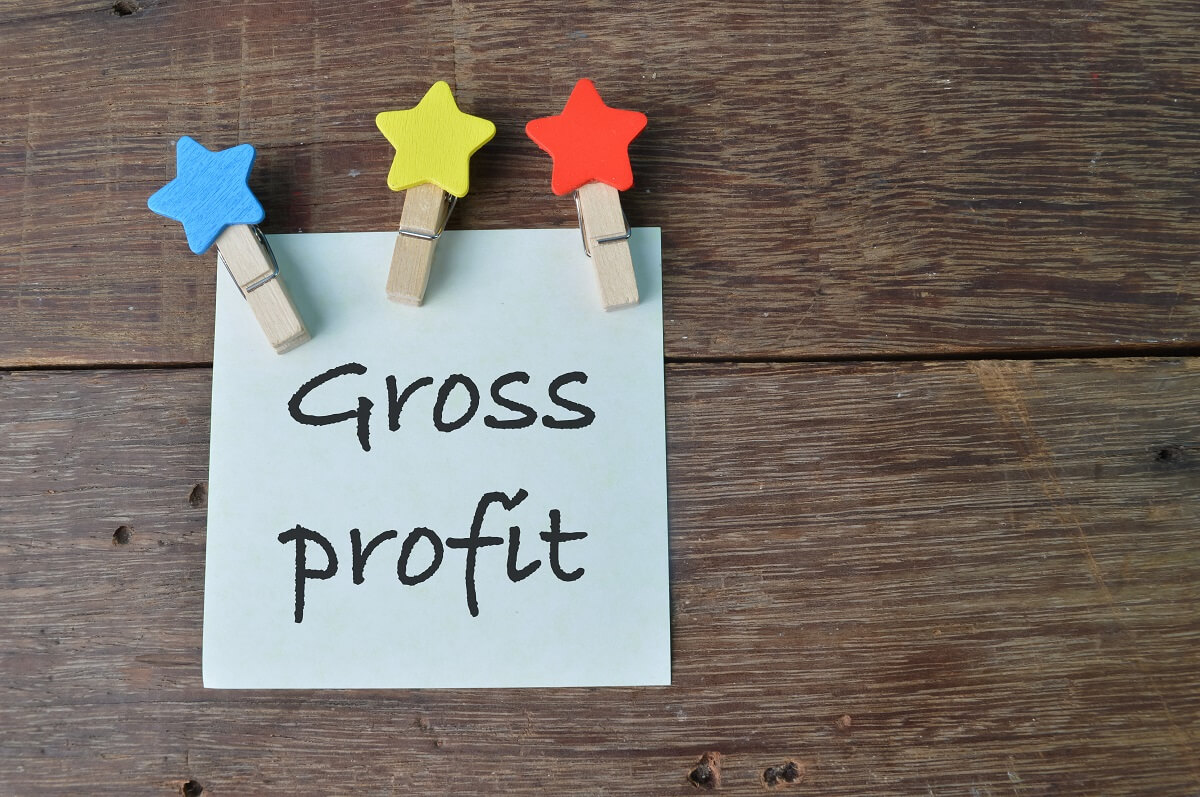Table of Contents
If your business is generating huge sales every month, that’s good to hear. However, you shouldn’t celebrate too soon. Relying solely on sales doesn’t really show that your business is making a profit.
On the other hand, gross profit margin is a good metric to measure your company’s profitability, not sales. Understanding your gross margins gives you valuable data to identify the most lucrative areas of your business and scale them.
Here’s a look at how to calculate gross profit and some of its examples.
What is a good gross profit margin?
Gross profit margin is a metric used to assess a company’s financial health and is equal to net sales minus the cost of goods sold as a percent of total sales.
A good profit margin depends on the type of business, such as retailers, restaurants, manufacturers, and other producers of goods. Generally, people consider a ratio of 50 – 70% to be a healthy gross profit.

Generally, people consider a ratio of 50 – 70% to be a healthy gross profit
However, a profit margin ratio of 50% for financial institutions, legal firms, or other service industry companies is considered low.
Meanwhile, service industries, especially banks, law firms, and technology businesses, typically report their gross profit margin in the 90% range. This is because companies in the service sector usually have much lower production costs than manufacturing businesses.
On the other hand, the gross profit ratio in clothing retailing can range from 3 – 13%, while some fast-food chains can achieve gross margins as high as 40%.
Therefore, you should determine what your type of business is before assessing your gross margins.
Why is gross profit margin important?
Gross margins are so crucial as they can help business owners and professional advisers assess a company’s financial health.
Moreover, you can also use it to track a company’s performance over time or to compare businesses in the same industry. It will not only tell you whether your business is achieving the industry benchmark but also be used as a target to exceed the industry average.
Track all your Profits & Losses in real-time

How to calculate gross profit margin?
To calculate the gross profit, you have to subtract direct expenses or cost of goods sold (COGS) from net sales (gross revenues minus returns, allowances, and discounts.) Then, you’ll divide that number by net revenues and multiply it by 100%.
| [(Net revenue – direct expenses) / Net revenue] x 100% = Gross margins ratio |
However, it would also mean that you need to keep track of these data in your business, and it’s usually challenging. Still, there is a good way to do so. If you happen to own a Shopify store, you can look for an app to back you up.
There are various options out there that you can choose from. Yet, we have discovered that TrueProfit from OneCommerce can be your best choice. This app helps you track everything happening in your Shopify store in just one dashboard. All you have to do is set things up once and let this app do the hard work.
Examples of Gross margin ratio
As an example of gross margin, a clothing maker might sell a T-shirt for £30. They cost £10 to make, yielding the retailer a gross profit of £20. This equates to a margin of 66%.
- Total product revenue: £30
- Total production costs: £10
- Gross profit: 30-10 = £20
- Gross profit margin: 20/30 x 100% = 66%

Examples of Gross margin ratio
Another example is the service-based business. Imagine your company is a financial firm that offers financial consulting to other businesses. A single consulting sells for £800 and costs £200 to produce, yielding a gross profit of £600. This is a margin of 75%.
- Total product revenue: £800
- Total production costs: £200
- Gross profit: 800-200 = £600
- Gross profit margin: 600/800 x 100% = 75%
What does Gross Profit Margin tell you?
The gross profit ratio is a useful metric for measuring how efficiently companies make money from products and services as it measures profit as a percentage of sales revenue. As a result, you can use it to compare businesses with various sales figures.
Gross margins also focus on sales revenue, reducing general corporate expenses and income that affects a company’s overall profitability.
Occasionally, gross margins are also used as a measure of how well a company is managed. High gross profit margins show that your business management is successful at making money from the labor and other expenses used in producing its goods and services.

Occasionally, gross margins are also used as a measure of how well a company is managed
Moreover, gross profit margins that significantly fluctuate from quarter to quarter or year to year may be a sign of bad management. Changes in gross profit margin come from temporary manufacturing issues that result in lower product quality and a higher level of product returns, hence reducing net sales revenue.
Rapidly declining profit margins can indicate a market with intense competition and commoditized products, where there is little differentiation between competing goods or services.

Rapidly declining profit margins can indicate a market with intense competition and commoditized products
In contrast, steadily increasing profit margins indicate fewer competitors in your industry, and your business can differentiate its products. So you can sell them at higher prices, but it may be a sign that your company is overpricing its products.
When your gross profit margin gradually decreases over time, you should make adjustments to facilitate growth. For example, you have to sell a greater volume of products to compensate for declining profitability. You can consider changing the business model, improving the manufacturing processes to produce products more efficiently, or cutting costs in other ways.
Limitations of the Gross Profit Margin
Though this ratio is useful, it does have some limitations:
- It doesn’t show a company’s overall profitability because it does not include all of the expenses.
- It may present an inaccurate view of profitability without the proper context. For instance, a company has to pay more for raw materials temporarily if its suppliers in a particular area shut down after a flood, or it may discount heavily in order to capture market share.
- It’s less valuable for comparing companies across different industries as the average gross margins vary by industry sector, largely because of differences in COGS.
How to improve your gross profit margin?
If your business’ gross margins can’t reach the industry average, you should consider improving this ratio. There are 4 ways to improve your gross margins: Streamline your offer, Negotiate with suppliers for better deals, Upsell to existing clients, and Increase efficiency and productivity.
1. Streamline your offer
Retail companies should review sales charts to determine which products have been the least lucrative or popular, and then remove them from the product line.

Streamline your offer
For example, Discussion Box has narrowed its focus to deliver services solely to senior women in business – carving out a niche within the saturated events industry has been key to increasing its prices and gross profit margin.
While its new approach did involve some compromises like a smaller target market, and there was also a financial and time cost involved in rebranding communications, the move saw its average order value increase significantly.
2. Negotiate with suppliers for better deals
If you purchase the materials from multiple suppliers, you’ll have bargaining power. In that case, you can ask for discounts if you purchase in bulk.

You should consider what you’re paying for that you don’t value
However, you should NOT be aggressive. Instead, you should consider what you’re paying for that you don’t value – and which of the supplier’s costs you can help reduce.
3. Upsell to existing clients
After your customers visit your website and make a purchase, can you persuade them to make larger purchases to raise your average order value? Can you entice your customers with impulsive purchases, or reach out to clients who have abandoned their carts via email system?

Upsell to existing clients
These 2 questions focus on client retention and repeat business as it costs us significantly less to sell to an existing client than to gain a new one altogether.
4. Increase efficiency and productivity
Is your business overstaffed? If yes, it will harm the gross profit margin. In fact, after experimenting with a four-day workweek, Microsoft Japan reported a 40% increase in productivity improvements and employee satisfaction.

Applying automating processes and building your own technology has also helped reduce direct costs
Furthermore, applying automating processes – and building your own technology – has also helped reduce direct costs. Automation reduces the odds of an error occurring, allows more accurate financial forecasting and efficient management of capital projects, and reduces employees in charge of repetitive tasks.
Final words
Calculating gross profit margin allows a business to understand its profitability in a general sense better and make informed decisions. If not managed properly, your company’s profit will be eaten by hidden costs.
When you find out that your gross margin is not high or negative, you should immediately make changes. You can start by making a plan to increase your gross margins.
However, you need a more accurate way to calculate your gross margins rather than make assumptions. In that case, you can try out TrueProfit. It will analyze and show you your gross profit margin. As a result, you’ll know which products are yielding high and low profits, hence making better investments.


